Materials
- Used generically for lead ores such as galena and lead oxides such as red lead
- Plumbago (mineral), an archaic word for the mineral form of graphite
- Plumbago drawing, graphite portraits of the seventeenth and eighteenth centuries
Plumbago may refer to:
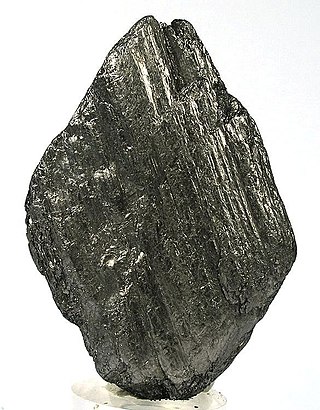
Graphite is a crystalline allotrope (form) of the element carbon. It consists of many stacked layers of graphene, typically in the excess of hundreds of layers. Graphite occurs naturally and is the most stable form of carbon under standard conditions. Synthetic and natural graphite are consumed on a large scale for uses in many critical industries including refractories (50%), lithium-ion batteries (18%), foundries (10%), lubricants (5%), among others (17%). Under extremely high pressures and extremely high temperatures it converts to diamond. Graphite's low cost, thermal and chemical inertness and characteristic conductivity of heat and electricity finds numerous applications in high energy and high temperature processes.

A pencil is a writing or drawing implement with a solid pigment core in a protective casing that reduces the risk of core breakage and keeps it from marking the user's hand.

Schist is a medium-grained metamorphic rock showing pronounced schistosity. This means that the rock is composed of mineral grains easily seen with a low-power hand lens, oriented in such a way that the rock is easily split into thin flakes or plates. This texture reflects a high content of platy minerals, such as mica, talc, chlorite, or graphite. These are often interleaved with more granular minerals, such as feldspar or quartz.

Molybdenite is a mineral of molybdenum disulfide, MoS2. Similar in appearance and feel to graphite, molybdenite has a lubricating effect that is a consequence of its layered structure. The atomic structure consists of a sheet of molybdenum atoms sandwiched between sheets of sulfur atoms. The Mo-S bonds are strong, but the interaction between the sulfur atoms at the top and bottom of separate sandwich-like tri-layers is weak, resulting in easy slippage as well as cleavage planes. Molybdenite crystallizes in the hexagonal crystal system as the common polytype 2H and also in the trigonal system as the 3R polytype.
A misnomer is a name that is incorrectly or unsuitably applied. Misnomers often arise because something was named long before its correct nature was known, or because an earlier form of something has been replaced by a later form to which the name no longer suitably applies, or in an attempt to falsely blame or embarrass like in the misnomer case of Spanish flu. A misnomer may also be simply a word that someone uses incorrectly or misleadingly. The word "misnomer" does not mean "misunderstanding" or "popular misconception", and a number of misnomers remain in common usage — which is to say that a word being a misnomer does not necessarily make usage of the word incorrect.

Cleavage, in mineralogy and materials science, is the tendency of crystalline materials to split along definite crystallographic structural planes. These planes of relative weakness are a result of the regular locations of atoms and ions in the crystal, which create smooth repeating surfaces that are visible both in the microscope and to the naked eye. If bonds in certain directions are weaker than others, the crystal will tend to split along the weakly bonded planes. These flat breaks are termed "cleavage". The classic example of cleavage is mica, which cleaves in a single direction along the basal pinacoid, making the layers seem like pages in a book. In fact, mineralogists often refer to "books of mica".
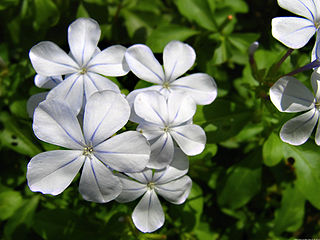
Plumbago is a genus of 23 species of flowering plants in the family Plumbaginaceae, native to warm temperate to tropical regions of the world. Common names include plumbago and leadwort.
Blacklead may refer to:

A protocarnivorous plant, according to some definitions, traps and kills insects or other animals but lacks the ability to either directly digest or absorb nutrients from its prey like a carnivorous plant. The morphological adaptations such as sticky trichomes or pitfall traps of protocarnivorous plants parallel the trap structures of confirmed carnivorous plants.

Plumbago auriculata, the Cape leadwort, blue plumbago or Cape plumbago, is a species of flowering plant in the family Plumbaginaceae, native to South Africa and Mozambique.

Leptotes is a butterfly genus in the family Lycaenidae. They are commonly known as zebra blues in reference to their zebra-striped undersides.
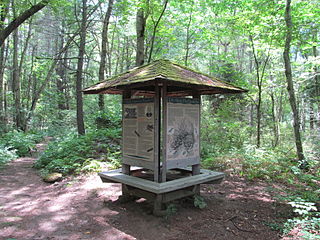
The Nashoba Brook Pencil Factory Site contains the ruins of a 19th-century dam-powered pencil factory. This factory was one of several in Acton and Concord, Massachusetts at the time that brought important developments to pencil manufacturing. All that remain today of the factory are the ruins of its dam and a few mechanical components. The site is in the Nashoba Brook Conservation Area in Acton, Massachusetts, along Nashoba Brook and the old Davis Road Dam. Visitors can access the site by following a marked path from the Davis Road parking area for the Nashoba Brook Conservation Area
Morgan Advanced Materials plc is a company which manufactures specialist products, using carbon, advanced ceramics and composites. The group is headquartered in Windsor, United Kingdom, and has 70 sites across 18 countries. It is listed as public limited company on the London Stock Exchange and is a component of the FTSE 250 Index.

Natural resource economics deals with the supply, demand, and allocation of the Earth's natural resources. One main objective of natural resource economics is to better understand the role of natural resources in the economy in order to develop more sustainable methods of managing those resources to ensure their availability for future generations. Resource economists study interactions between economic and natural systems, with the goal of developing a sustainable and efficient economy.

Leptotes cassius, the Cassius blue or tropical striped blue, is a butterfly of the family Lycaenidae. It is found in North America in Florida including the Keys, Texas south through the Caribbean, Mexico, and Central America to South America. Strays have been found in New Mexico, Kansas, Missouri, South Carolina, North Carolina and Virginia.

Plumbago zeylanica, commonly known as Ceylon leadwort, doctorbush or wild leadwort, is a species of plumbago with a pantropical distribution. Carl Linnaeus described the paleotropical P. zeylanica and Neotropical P. scandens as separate species, but they are currently considered synonymous.
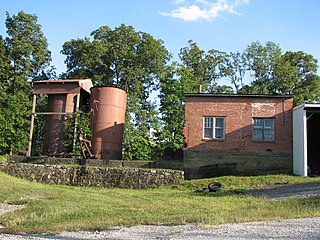
Byers Station Historic District is a national historic district located in Upper Uwchlan Township, Chester County, Pennsylvania, United States. The district includes 26 contributing buildings in the crossroads community of Byers Station. The buildings date to the 19th century and include a number of notable Italianate style buildings. Notable buildings include a variety of residences, a factory, a Masonic lodge (1894), and the former Byers Hotel. The community grew around the Byers railroad station, after its opening in 1871, and continued after plumbago (graphite) was discovered in the area in 1875.
Graphite mining in Sri Lanka has occurred since the Dutch occupation of the country. It is the only country in the world to produce the purest form of graphite, vein graphite, in commercial quantities, currently accounts for less than 1% of the world graphite production. Graphite mines were mostly located in north western and south western parts of the island, with working pits located in Aluketiya, Meegahatenna, Matugama and Agalawatta. The Geological Survey Department, started in 1903, maintained records of all graphite pits, shallow workings and mines under the Inspector of Mines. However these records were lost when the Geological Survey and Mines Bureau was established in 1992. The miners were Singhalese peasants, using primitive methods for driving shafts, adding to local folklore. Through plumbago mining, entrepreneurs such as Don Charles Gemoris Attygalle, Don Spater Senanayake and Duenuge Disan Pedris made their fortunes leading to many of the larger mines coming under the control several business families such as the Senanayakes, Kotalawelas and De Mels. These families dominated the pre-independence and post-independence political landscape in Ceylon, with membership in the United National Party. Many of these politicians established their constituencies in these mining areas, where they traditionally had influence over the villages employed in their mines. Sri Lanka's current annual production is 9,000 to 10,000 tons for two underground mines, one of which is Kahatagha and Bogala.
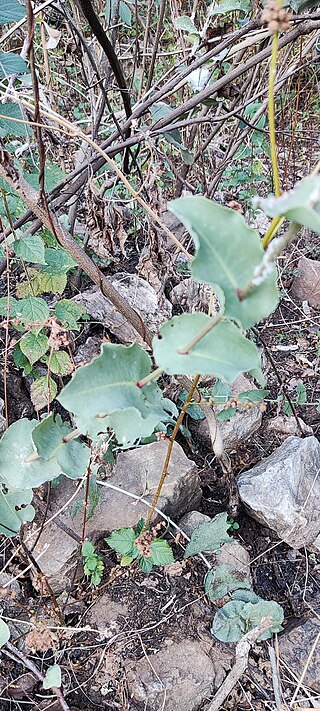
Plumbago arabica is a species of flowering plant in the genus Plumbago. It is a subshrub native to western and central India and to Oman and the United Arab Emirates in the southeastern Arabian Peninsula, where it grows in deserts and dry shrublands.